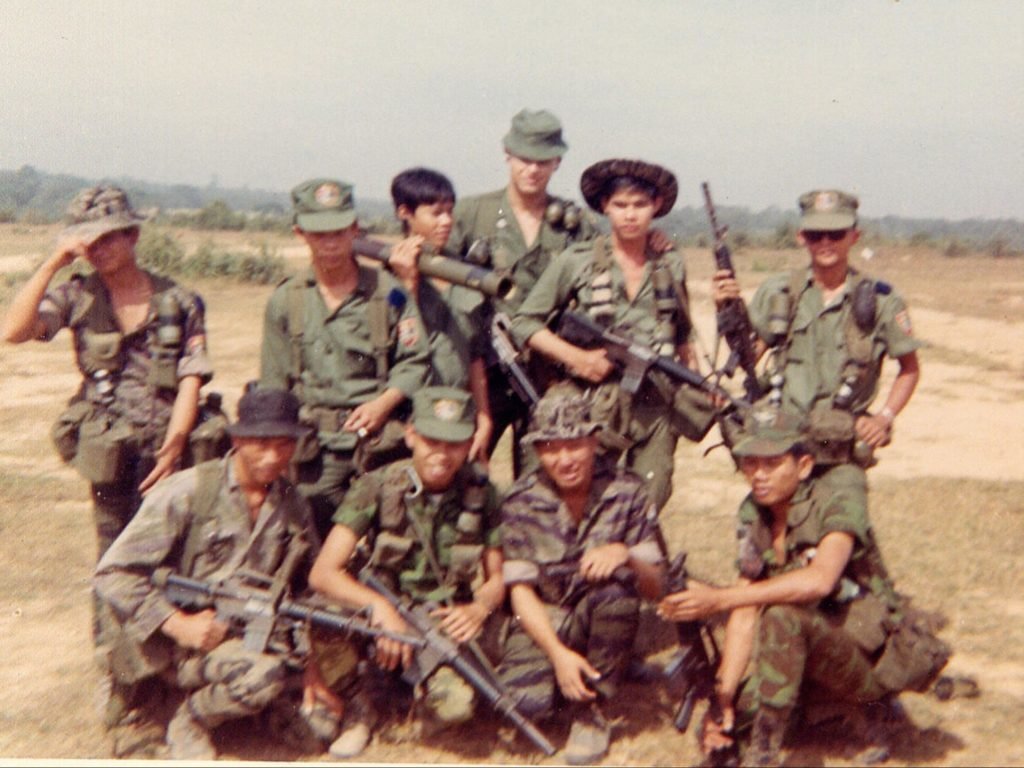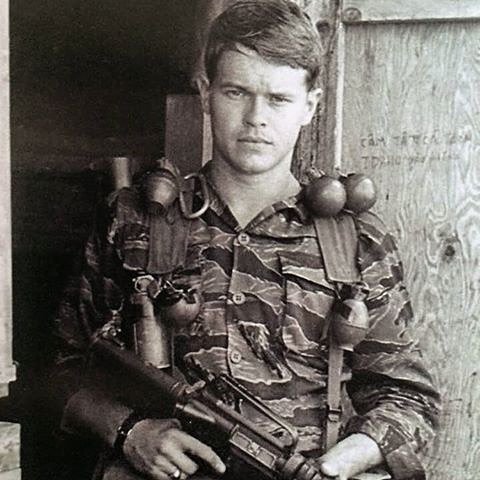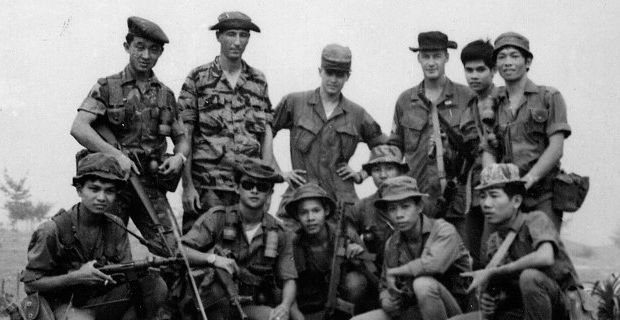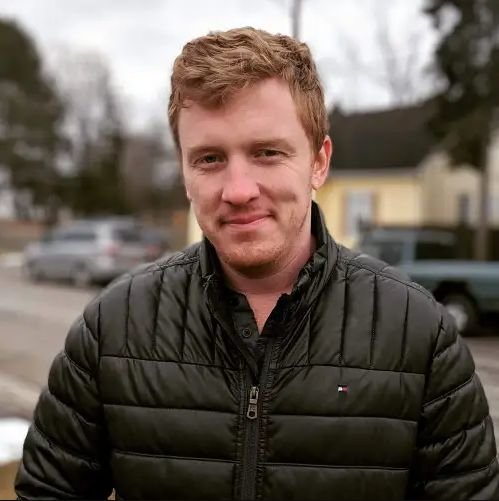
Phu Bai- ST Idaho team room, from left, Sau, Tilt, Hiep, Lynne Black Jr. Photo courtesy of John Styker Meyer via SFA 78.
Coffee or Die had the honor of speaking with John Meyer for this story, which can be read in his own words in his memoir, “Across The Fence: The Secret War in Vietnam (Expanded Edition)©,” among a good many other MACV-SOG stories.
Cambodia, 1968. John Stryker “Tilt” Meyer’s feet dangled off a U.S. Air Force UH-1F helicopter, overlooking the Cambodian jungles that appeared to be untouched by civilization. He was a young man — just 22 years old — though his eyes told a different story. He did not think he would live to be 23.
Through a rare series of events, his belly was full. He and his team had just enjoyed a hefty Thanksgiving feast, and they were filled to the brim. Death may have been around the corner, but Meyer figured that if you’re going to have a last meal, a Thanksgiving dinner wasn’t a bad choice.
However, his mind was on the dense green expanse — not the Thanksgiving dinner or lingering thoughts of home. His eyes were honed and focused on the here and now. These trees aren’t nearly as dense as they ought to be, he thought. This is like the woods back in Jersey — I wish it was like it was in Laos. They weren’t so sparse in Laos, at least we had decent concealment then.

The helicopter thundered across the jungle, and his eyes scanned the trees. U.S. forces had lost track of three North Vietnamese Army (NVA) divisions, lurking somewhere out there in the jungle — it was the job of Meyer’s unit to find them.
Meyer glanced over to “Bubba,” the other American MACV-SOG (Military Assistance Command Vietnam-Studies and Observations Group) operative on his team (designated ST Idaho). Bubba was a little incredulous when he first heard the mission parameters. “Three divisions?” He shook his head, wondering how one could simply lose track of that many men. Now he was gripping his CAR-15, a sawed-off M79 at his side. His loadout was identical to Meyer’s; both men hoped they would be in and out without shooting anything but their recon cameras.
Meyer’s eyes drifted to the rest of ST Idaho, the Vietnamese men who had several lifetime’s worth of fighting experience under their belts. They were Sau, Hiep, Phuoc, and Tuan. They all carried claymores, grenades, and were heavy on ammunition — but light on food and water.

The U.S. Air Force crew, known as the Green Hornets, were thundering just over the treetops. Their speed and proximity to the branches made Meyer’s stomach turn, but before he had time to think twice, the aircraft flared and they touched down on the landing zone (LZ).
It was time to start looking.
As they slid out of the helicopter, the Air Force pilots dissolved beyond the horizon. Moments later, the sky was clear and a familiar silence settled upon them, the sort of silence that wraps itself around you after a tremendous noise suddenly disappears.
I can see the sky. Meyer’s experience fighting clandestine missions in Laos had given him few comforts — heavy concealment was one of them. Now, the rays of the sunlight easily poked through the thin canopy above. He knew that if the sun could spot him, so could the NVA.
Meyer was a practical man, and he knew there was no sense in lamenting things that could not be changed. He and his men spread out, and they set the fuses on their claymores to five and 10 seconds.

This wasn’t a large military operation with a thousand moving parts or a campaign designed by a think-tank. It was six highly trained men in a country they were not supposed to be in, looking for three divisions of enemy soldiers in the jungle: the 1st, 3rd, and 7th NVA divisions. They spoke little to one another, only exchanging the words that were of the highest importance.
It wasn’t long before Sau spotted smoke. Meyer directed him and Phuoc to move forward and see what was ahead. They returned quickly with wide eyes. In a moment, their mission was complete as they had found the NVA — but with one problem.
They had wandered right into the center of the enemy divisions. The smoke was from a dying fire, and it was sheer luck that they had not run into any NVA on the way toward it. Now, other temporary military settlements were on every side.
We just stumbled into an NVA base camp. If Meyer’s stomach had turned during the flight in, it was doing flips now. Why have we seen no troops? Where is everyone?

Meyer had been running MACV-SOG missions for five months by this time; Sau had been battling the NVA for the last three years. His eyes had never been so wide, and he had never spoken so quickly — to see fear in a fearless man was unsettling.
A part of Meyer called him deeper into the camp, hoping to find more definitive proof of the divisions’ presence there. He wanted to take pictures of a weapons cache or find a group of enemy soldiers around one of the fires.
Sau looked right at Meyer and spoke with a troubling seriousness: “Call helicopters now! Beaucoup VC come now!”
Meyer had doubted Sau once before, back in Laos. He wasn’t about to make that mistake again. This man was a legend in his own right, and if he was worried, then Meyer knew he ought to be worried, too. If he’s overreacting — which would be very unlike him — we’ll deal with it later. We’ve got no fixed-wing aircraft, no backup. There was only one way out: the way they came in.

They hadn’t moved far when he heard the words, confirming their fears. “Beaucoup VC! Beaucoup VC!” It was Sau, and they had been discovered. Turning his head, Meyer caught a glimpse of pith helmets in the distance, headed directly toward their position. Sau hissed at Hiep and pointed in the opposite direction.
Damn! They’re coming at us from both sides.
The NVA were on to them, and Meyer could see they were running now. They were two pincers moving at breakneck speed toward ST Idaho, stuck in the middle.
Well, at least we found the lost divisions, Meyer thought. He may have smirked, had the situation not been so dire.
That’s when the signature silence of the jungle disappeared. The air exploded with gunfire on both sides, rounds screamed past Meyer and his men, and leaves and bark began disintegrating around and above them. He could see the green AK47 tracer rounds painting the sky above.

The rest of ST Idaho began to break contact as Sau and Meyer stayed behind to plant a claymore. They slammed it into the ground, initiated it, and barrelled back to the team. They did not wait to watch it explode seconds later.
The NVA was running and shooting wildly now, right on their tail like some chaotic machine of death, spitting fire and lead and cutting through the trees. Meyer and the others fired as they moved, careening back to the LZ like they had awoken a living nightmare.
However, they met the fire of the NVA with fire of their own. Bubba set a trip-wire-activated claymore; he and Meyer gave away their position by letting loose a hellfire of 40mm grenades by way of their sawed-off M79s. As NVA troops closed in on them, the claymore detonated, keeping the waves of NVA at bay.
Every moment that passed felt as if it would be the last one. And in one of those moments, when hope was ticking away with the seconds, Meyer heard a friendly gunship roar overhead. Its guns hammered into the NVA, cutting apart bodies with the ease that their weapons had cut apart the trees.
Meyer had doubted Sau once before, back in Laos. He wasn’t about to make that mistake again.
Later, Meyer acknowledged that if it weren’t for the helicopter’s prompt return, ST Idaho would have been little more than a few corpses in the jungle. But there was no time to think about that now. He set up one more claymore at the edge of the LZ and watched as it exploded on yet another pulsating wave of NVA troops.
There were precious seconds to make it to the clearing now. He and his team picked up and made one last dash for the helicopter, which had just touched down. They dove in and continued to fire alongside the door gunner onboard.
Just as they lifted into the air, another wave of NVA men reached the clearing. One man in particular sprinted into the clearing, raising his rifle with hostile intent. Meyer took aim and pulled the trigger.
Those moments were like slow motion. The man rocked backward as Meyer peered through the shell casings spewing from the door gunner’s machine gun as he engaged other men. The NVA, taking Meyer’s rounds to the chest, doubled backward, driving him into the woods as if he were consumed by the jungle itself.

In a flash, they were airborne and miles away. No one was shooting now, though their hearts were still pounding. The door gunner turned to Meyer and pumped his fist in the air, his body likely tingling with adrenaline from another close call. But Meyer didn’t share his enthusiasm. “We had been moments away from a very violent death and we had killed an untold number of NVA soldiers — soldiers who continued to earn our undying respect. I took no pleasure in killing the enemy. It was simply us or them,” Meyer described in his book.
When they landed, Meyer and Bubba went to the Air Force mess facility and tracked down a second Thanksgiving dinner. After that, the officer who had sent them on the mission asked if they wouldn’t mind explaining its details over dinner. They accepted and ate their third Thanksgiving meal of the day. Meyer ensured that Hiep, Sau, Phuoc, and Tuan received the same treatment.
This was one of many missions of the men MACV-SOG carried out during the Vietnam War. These clandestine missions were not only unimaginably dangerous, but they were frequent. Indeed, it wouldn’t be 24 hours before Meyer and the rest of ST Idaho would be assigned their next objective.

Luke Ryan is the author of two books of war poetry: The Gun and the Scythe and A Moment of Violence. Luke grew up overseas in Pakistan and Thailand, the son of aid workers. Later, he served as an Army Ranger and conducted four deployments to Afghanistan, leaving as a team leader. He has published over 600 written works on a variety of platforms, including the New York Times.
BRCC and Bad Moon Print Press team up for an exclusive, limited-edition T-shirt design!
BRCC partners with Team Room Design for an exclusive T-shirt release!
Thirty Seconds Out has partnered with BRCC for an exclusive shirt design invoking the God of Winter.
Lucas O'Hara of Grizzly Forge has teamed up with BRCC for a badass, exclusive Shirt Club T-shirt design featuring his most popular knife and tiomahawk.
Coffee or Die sits down with one of the graphic designers behind Black Rifle Coffee's signature look and vibe.
Biden will award the Medal of Honor to a Vietnam War Army helicopter pilot who risked his life to save a reconnaissance team from almost certain death.
Ever wonder how much Jack Mandaville would f*ck sh*t up if he went back in time? The American Revolution didn't even see him coming.
A nearly 200-year-old West Point time capsule that at first appeared to yield little more than dust contains hidden treasure, the US Military Academy said.












